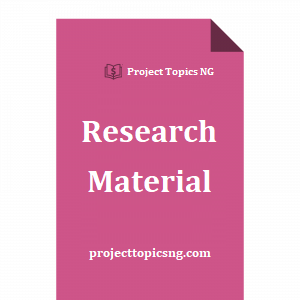Brief Introduction
Sweet potato (Ipomoea batatas) is an important food crop in the tropical and sub tropical countries and belongs to the family convolvulaceae. It is cultivated in more than 100 countries. ( Woolfe, 1992). Nigeria is the third largest producer in the world with china leading, followed by Uganda. Sweet potato ranks seventh among the world food crops, third in value of production and fifth in caloric contribution to human diet (Bouwkamp, 1985). Sweet potatoes are rich in dietary fibre, minerals, vitamins and anti oxidants such as phenolic acids, anthocyanins, tocopherol and ß- carotene.
Besides acting as anti oxidants, carotenoids and phenolic compounds also provide sweet potatoes with their distinctive flesh colours ( cream, deep yellow, orange and purple). Sweet potato blends with rice, cowpea and plantain in nigerian diets. It is also becoming popular as a substitute to yam and garri. It can be reconstituted into fofoo or blended with other carbohydrate flour sources such as wheat ( Triticum aestivum) and cassava ( Manihot esculenta) for baking bread, biscuits and other confectioneries (Woolfe, 1992).
The leaves are rich in protein and the orange flesh varieties contain high beta carotene and are very important in combating vitamin A deficiency especially in children.
Sorghum (sorghum bicolor (S. bicolor) is a tropical plant belonging to the family of poaceae, is one of the most important crops in Africa, Asia and Latin America. More than 35% of sorghum is grown directly for human consumption.
Table of Content
TITLE PAGE
CERTIFICATION
DEDICATION
ACKNOWLEDGEMENT
ABSTRACT
TABLE OF CONTENTS
CHAPTER ONE:
INTRODUCTION
CHAPTER TWO:
LITERATURE REVIEW
2.1. ORIGIN AND DISTRIBUTION OF SWEET POTATO
2.1.1. DESCRIPTION OF SWEET POTATO PLANT
2.1.2. USES OF SWEET POTATO
2.1.3. NUTRITIONAL VALUE OF SWEET POTATO
2.1.4. ANTI- NUTRITIONAL FACTORS
2.1.5. NUTRIENT COMPOSITION OF SWEET POTATO
2.1.5.1. POLYPHENOLS COMPOSITION
2.1.5.2. ANTI-OXIDATIVE, ANTI-MUTAGENICITY AND ANTI-CARCINOGENICITY
2.1.6. ANTI-DIABETES
2.1.7. ANTI-NUTRIENTS IN SWEET POTATO
2.1.8. ENZYME COMPOSITION OF SWEET POTATO
2.2. ORIGIN AND DISTRIBUTION OF SORGHUM PLANT
2.2.1. DISTRIBUTION OF SORGHUM PLANT
2.2.2. USES OF SORGHUM
2.2.3. ENZYME COMPOSITION OF SORGHUM
2.2.4. NUTRITIONAL COMPOSITION OF SORGHUM
2.2.5. ANTI-NUTRIENTS IN SORGHUM
CHAPTER THREE:
MATERIALS AND METHODS
3.1. MATERIALS
3.2. METHODOLOGY
3.2.1. PROCESSING OF SWEET POTATO TUBER
3.2.2. PROCESSING OF SORGHUM GRAIN
3.3. SWEET POTATO AND SORGHUM ANALYSIS
3.3.1. PROXIMATE ANALYSIS
3.3.1.0. DETERMINATION OF FAT CONTENT
3.3.1.1. DETERMINATION OF ASH CONTENT
3.3.1.2. DETERMINATION OF CRUDE FIBRE
3.3.1.3. DETERMINATION OF MOISTURE CONTENT
3.3.1.4. DETERMINATION OF PROTEIN
3.3.1.5. DETERMINATION OF CARBOHYDRATES
3.4. ANTI-NUTRIENTS AND PHYTOCHEMICALS
3.4.1. DETERMINATION OF TANNINS
3.4.2. DETERMINATION OF HYDROCYANIC ACID
3.4.3. DETERMINATION OF ANTHOCYANNINS
3.4.4. DETERMINATION OF PHYTATE/PHYTIC ACID
3.5. DETERMINATION OF MINERAL CONTENT
3.5.1. MAGNESIUM
3.5.2. IRON
3.5.3. ZINC
3.5.4. PHOSPHOROUS
3.5.5. POTASSIUM
3.6. DETERMINATION OF PASTING PROPERTIES
3.7. DETERMINATION OF PHENOL OXIDASE
3.8. DETERMINATION OF REDUCING SUGARS; FRUCTOSE, GLUCOSE AND SUCROSE
CHAPTER FOUR:
RESULTS AND DISCUSSION
4.1. TABLE 1: PROXIMATE COMPOSITION OF THE SAMPLES AND DISCUSSION
4.2. TABLE 2: MINERAL COMPOSITION OF SAMPLES AND DISCUSSION
4.3. TABLE 3: PHYTOCHEMICAL COMPOSITION OF THE SAMPLES AND DISCUSSION
4.4. TABLE 4: PHYSICO-CHEMICAL PROPERTIES OF SAMPLES AND DISCUSSION
4.4. TABLE 5: SUGAR COMPOSITION OF THE SAMPLES AND DISCUSSION
CHAPTER FIVE:
CONCLUSION
REFERENCES


